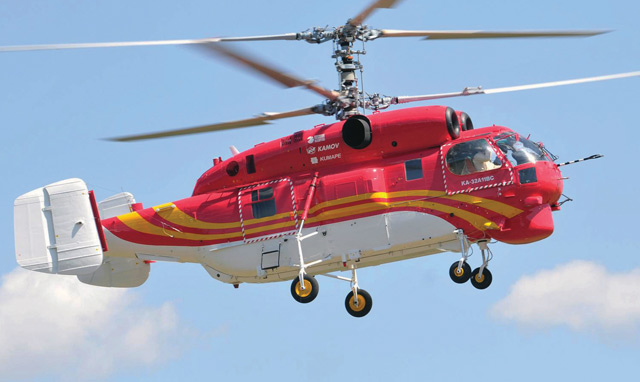For Russian Helicopters, the parent company behind the Mil and Kamov brands, 2013 marked another year of steady-as-she-goes progress.
Revenue gained a healthy 10% to Rb138 billion ($3.9 billion), EBITDA jumped by 27% to Rb26.3 billion, with the EBITDA margin pushing toward 20%.
The bottom line was up a little more than 1% at Rb9.5 billion, but total capital investment was ramped up by a quarter, to Rb16.2 billion. Indeed, 2013 followed a string of similarly good years from 2010, when the state-owned firm completed its strategic objective of consolidating the ex-Soviet helicopter industry under a single management. That consolidation was certainly important and – as the numbers indicate – appears to be bearing fruit.

Russian Helicopters
As company insiders note, the Mil and Kamov operations were hit especially hard by the economic and political chaos that followed the collapse of the USSR, with the end of central control exposing the obvious weakness in the Soviet system, which separated design from manufacturing. The unsurprising result was that the Mil and Kamov design bureaus were left scrambling for “commercial activities” to stay solvent, and individual factories took on sales and design work. The popular Mil Mi-8/17 series, for example, remained at least nominally uniform, despite being manufactured independently by plants in Kazan and Ulan Ude. However, nobody was properly responsible for warranties, and there was no unified after-sales service regime.
A proliferation of independent workshops, especially in Africa, ended up trading – wittingly or otherwise – in a sea of undocumented and counterfeit parts.
Russian Helicopters has been able to push hard to take a grip on these problems. Formal service arrangements, for example with Denel in South Africa, should build customer confidence. The various production plants have been brought into a unified corporation. Notably, in late 2013 Kazan Helicopters chief Vadim Ligay and Ulan-Ude’s first deputy managing director Vyacheslav Kozlov were appointed deputies to chief executive Alexander Mikheev, who took over from Dmitry Petrov in September 2013. Petrov steered the consolidation and now works within ultimate parent Rostec.
So, given the story of the past two decades, the progress of the past four years is noteworthy – if not spectacular. For 2013, production of 275 aircraft for Russian and international customers fell compared with the 290 delivered in 2012. Efficiency appears to be improving, however, on the back of investment in processing, plating and composite materials production, helping to lift output per employee by 12.4% to Rb3.4 million.
Mikheev says the slight decline in deliveries in 2013 was due to rescheduling of handovers rather than any production or sales slowdown. The firm order backlog stood at 808 units worth Rb401 billion as of end-2013, and 100% of the 2014 delivery plan of 303 units is for firm orders.
For 2014, says Mikheev, key priorities will be “slashing the timeframe for bringing the new multirole [Kamov] Ka-62, Mi-38 and Mi-171A2 to market”. Certification and entry into service of the former will be crucial for the company. Although its helicopters continue to sell strongly in its home market – particularly to Russia’s armed forces – the 6.5t Ka-62 represents its most Western-centric model to date, in terms of systems, appearance and export potential. First flight was previsioned last year, but this has slipped into 2014. And as for the Mi-38, a maiden sortie was undertaken in 2003, but the third prototype only performed an initial hover trial late last year. All this while also proceeding with development of the all-new 2.5t light helicopter Russian is to produce with AgustaWestland, following the companies’ late-2013 agreement.
Some milestones reached over the past few months are noteworthy. Kazan Helicopters this year built its 3,500th export-version Mil Mi-8/17 – one of 151 Mi-17V-5s ordered by India’s armed forces since 2008. In September 2013, the company finally achieved civil certification of its Kazan Ansat light twin.
Meanwhile, a publicity coup rounded off 2013 when a Kamov Ka-32A11BC enabled a dramatic Antarctic rescue. The helicopter (pictured), based on the Chinese icebreaker Xue Long, made five flights on 2 January to evacuate passengers aboard a research vessel that had got trapped in sea ice about 1,500nm (2,800km) from Australia on Christmas Eve.
Momentum, then, appears to carrying the company in the right direction. Indeed, the main criticism typically hurled at Russian Helicopters is arguably trivial – nobody trapped on the Antarctic ice was sorry to see it arrive, but as the Ka-32 well illustrates, one of Mikheev’s next priorities might be to shake up the styling department.
Source: Flight International



















